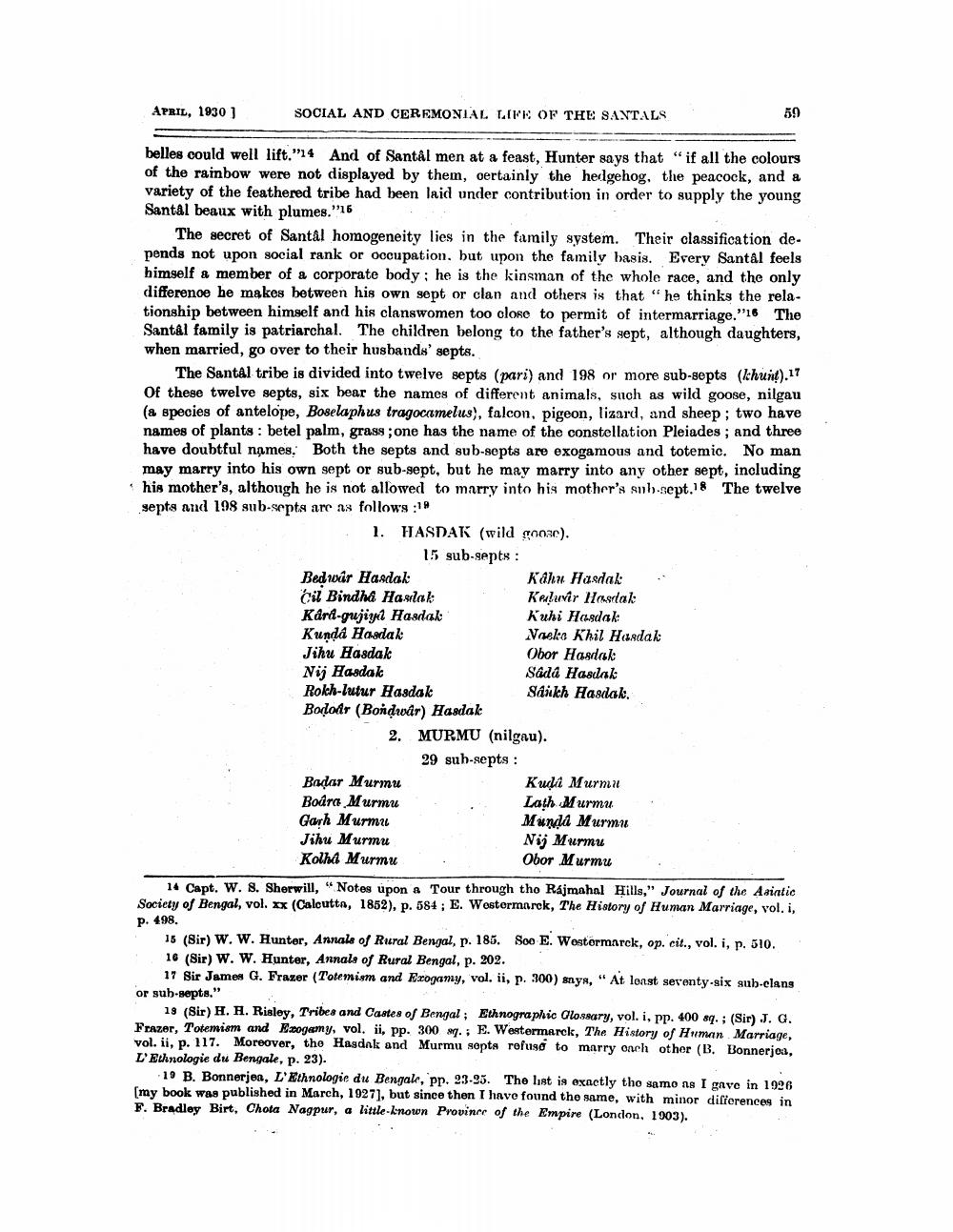________________
APRIL, 1930 ]
SOCIAL AND CEREMONIAL LIFE OF THE SANTALS
59
belles could well lift."14 And of Santal men at a feast, Hunter says that "if all the colours of the rainbow were not displayed by them, certainly the hedgehog, the peacock, and a variety of the feathered tribe had been laid under contribution in order to supply the young Santal beaux with plumes."16
The secret of Santal homogeneity lies in the family system. Their classification depends not upon social rank or occupation, but upon the family basis. Every Santal feels himself a member of a corporate body; he is the kinsman of the whole race, and the only difference he makes between his own sept or clan and others is that "he thinks the relationship between himself and his clanswomen too close to permit of intermarriage.”16 The Santal family is patriarchal. The children belong to the father's sept, although daughters, when married, go over to their husbands' septs.
The Santal tribe is divided into twelve septs (pari) and 198 or more sub-septs (khunt).17 Of these twelve septs, six bear the names of different animals, such as wild goose, nilgau (a species of antelope, Boselaphus tragocamelus), falcon, pigeon, lizard, and sheep; two have names of plants: betel palm, grass ; one has the name of the constellation Pleiades; and three have doubtful names. Both the septs and sub-septs are exogamous and totemic. No man may marry into his own sept or sub-sept, but he may marry into any other sept, including his mother's, although he is not allowed to marry into his mother's sub.sept.18 The twelve septs and 198 sub-septa are as follows :18
1. HASDAK (wild goose).
15 sub-septs : Bed wir Hasdak
Kahu Hasdak Cil Bindha Haslal
Kuvir Hasdak Kara-gujiyel Hasdak
kuhi Hasdak Kunda Hasdak
Vaske khil Hasdak Jihu Hasdak
Obor Hasilat Nij Hasdak
Sada Hasdak Rokh-lutur Hasdak
Saikh Hasdak. Bododir (Bordwar) Hasdak
2. MURMU (nilgau).
29 sub-septs : Badar Murmu
Kui Murma Bodra Murmu
Lath Murmu Garh Murmu
Munda Murmu Jihu Murmu
Nij Murmu Kolha Murmu
Obor Murmu
14 Capt. W. S. Sherwill, "Notes upon a Tour through tho Rajmahal Hills," Journal of the Asiatic Society of Bengal, vol. xx (Calcutta, 1852), p. 584 ; E. Westermarck, The History of Human Marriage, vol. i, p. 498.
15 (Bir) W. W. Hunter, Annals of Rural Bengal, p. 185. Soo E. Westermarck, op. cit., vol. I, p. 510. 16 (Sir) W. W. Hunter, Annals of Rural Bengal, p. 202.
17 Sir James G. Frazer (Totemism and Exogany, vol. ii, p. 300) snya, "At lonst seventy-six sub-clans or sub-septs."
19 (Sir) H. H. Risley, Tribes and Castes of Bengal; Ethnographic Glossary, vol. I, pp. 400 sq. ; (Sir) J. G. Frazer. Totemism and Epogany, vol. ii, pp. 300 .: E. Westermarck, The History of Human Marriage, vol. ii, p. 117. Moreover, the Hasdak and Murmu septa refuso to marry onch other (B. Bonnerjea, L'Ethnologie du Bengale, p. 23).
19 B. Bonnerjea, L'Ethnologie du Bengale, pr. 23-25. The list is exactly tho samo na I gave in 1926 (my book was published in March, 1927), but since then I have found the same, with minor differences in F. Bradley Birt, Chota Nagpur, a little-known Province of the Empire (London, 1903).




